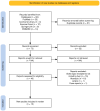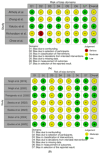Efficacy and Safety of GLP-1 Receptor Agonists and SGLT-2 Inhibitors in the Treatment of Diabetes Mellitus and Obesity in Liver Transplant Recipients: A Systematic Review
- PMID: 40648992
- PMCID: PMC12251260
- DOI: 10.3390/jcm14134619
Efficacy and Safety of GLP-1 Receptor Agonists and SGLT-2 Inhibitors in the Treatment of Diabetes Mellitus and Obesity in Liver Transplant Recipients: A Systematic Review
Abstract
Background/Objectives: Glucagon-like peptide-1 receptor agonists (GLP-1RAs) and sodium-glucose cotransporter-2 inhibitors (SGLT-2Is) have significantly improved the management of diabetes mellitus (DM). In the general population, these drugs have additional benefits, such as weight loss, improvement of liver steatosis, and a cardiorenal protective effect. However, data regarding the effects of GLP-1RAs or SGLT-2Is in the treatment of posttransplant diabetes mellitus (PTDM), obesity, and their potential cardiorenal protective effects in liver transplant (LT) recipients remain limited. PTDM increases the risk of developing graft steatosis, experiencing major cardiovascular events (MACEs), and developing chronic kidney disease and reduces long-term survival in LT recipients. The aim of this systematic review was to evaluate the efficacy and safety of GLP-1RAs and SGLT-2Is in the treatment of PTDM in LT recipients. Methods: Twelve retrospective studies (five specifically conducted in LT recipients and seven in mixed solid organ transplant cohorts, including LT recipients) that collectively enrolled 402 LT recipients treated with GLP-1RAs and/or SGLT-2Is for PTDM were selected. Results: GLP-1Ras and SGLT-2Is reduced serum glycated hemoglobin levels, body weight, and insulin requirements in LT recipients. Some studies reported benefits in reducing graft steatosis, improving renal function, and in reducing the occurrence of MACEs. Common adverse events included gastrointestinal symptoms, which rarely required treatment discontinuation. Conclusions: GLP-1RAs and SGLT-2Is represent promising treatment options for PTDM in LT recipients, offering metabolic benefits with manageable side effects. However, further prospective studies are needed to establish the long-term safety and efficacy, as well as the favorable impact on patient survival, of these drugs in LT recipients.
Keywords: glucagon-like peptide-1 receptor agonists; graft steatosis; liver transplantation; obesity; posttransplant diabetes mellitus; sodium-glucose cotransporter-2 inhibitors.
Conflict of interest statement
The authors declare no conflicts of interest.
Figures


Similar articles
-
Efficacy and tolerability of sodium-glucose co-transporter-2 inhibitors and glucagon-like peptide-1 receptor agonists: A systematic review and network meta-analysis.Diabetes Obes Metab. 2020 Jul;22(7):1035-1046. doi: 10.1111/dom.14008. Epub 2020 Mar 18. Diabetes Obes Metab. 2020. PMID: 32077218
-
Efficacy and safety of drugs for people with type 2 diabetes mellitus and chronic kidney disease on kidney and cardiovascular outcomes: A systematic review and network meta-analysis of randomized controlled trials.Diabetes Res Clin Pract. 2023 Apr;198:110592. doi: 10.1016/j.diabres.2023.110592. Epub 2023 Feb 25. Diabetes Res Clin Pract. 2023. PMID: 36842477
-
Incretin mimetics and sodium-glucose co-transporter 2 inhibitors as monotherapy or add-on to metformin for treatment of type 2 diabetes: a systematic review and network meta-analysis.Acta Diabetol. 2021 Jan;58(1):5-18. doi: 10.1007/s00592-020-01542-4. Epub 2020 Jun 8. Acta Diabetol. 2021. PMID: 32514989
-
Efficacy and safety of GLP-1 receptor agonists versus SGLT-2 inhibitors in overweight/obese patients with or without diabetes mellitus: a systematic review and network meta-analysis.BMJ Open. 2023 Mar 7;13(3):e061807. doi: 10.1136/bmjopen-2022-061807. BMJ Open. 2023. PMID: 36882248 Free PMC article.
-
Glucose-Lowering Medications and Risk of Chronic Obstructive Pulmonary Disease Exacerbations in Patients With Type 2 Diabetes.JAMA Intern Med. 2025 Apr 1;185(4):399-410. doi: 10.1001/jamainternmed.2024.7811. JAMA Intern Med. 2025. PMID: 39928303
References
Publication types
LinkOut - more resources
Full Text Sources

